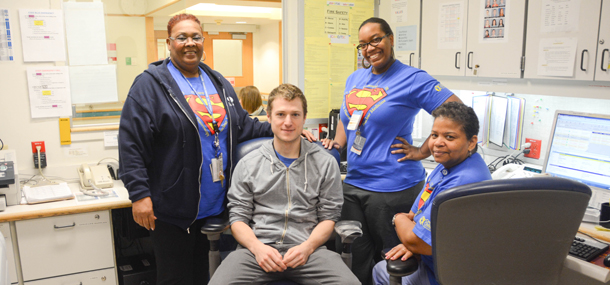
Cincinnati Children’s Radiology Department is always striving to give you and your family the best experience possible when your child is referred for a radiology examination. For many years, our overall guiding principle has been to do for your children what we would do for our own.
Twenty years ago, our radiology department was very different. At that time, all of our medical images, including traditional x-rays, CT scans, MRI scans, ultrasound examinations etc., were printed out on hard copy films. That’s the big black sheets of physical film that you see on television shows and movies. There was a very complicated system that involved many file room clerks to help retrieve old x-rays from outpatient clinics and inpatient units, file them away, and organize the new ones that needed to be read by the radiologist, who is a specialist physician trained in the interpretation of the medical images.
Because there were so many films, we had three different storage areas that housed past images; there was quite a bit of room for mistakes to happen and films to be misplaced. In those days, the radiologists’ reports were typed out manually on paper and often distributed by mail. It was not uncommon for the radiologists’ reports to take days to get to the ordering physicians. When there was an important or unexpected positive finding, however, the radiologist had a responsibility to notify the caring physician immediately so the patient could be taken care of. This meant that the busy radiologists were spending a lot of non-productive time on the phones and on hold with doctors’ offices, and that just added to the delays.
Our radiologist leaders were aware that our system wasn’t working as optimally as it could and some of them, along with other members of the radiology department and hospital, got together to figure out how we could do better. In the late 1990’s the radiology department teamed up with GE and transitioned to computerized digital imaging now known internationally as PACS. The radiology technologists could then upload the medical images directly into a computerized system and it was then instantly available to all medical staff who needed to see the images and reports.
Once we went digital and over the next several years, there was less of a need for the file room clerks, but still a big need for the radiologists to have someone answering the phones for them and contacting doctor’s offices when something significant was found. Some of the file room clerks were retrained as reading room assistants and now worked in the reading room beside the radiologists to do the necessary clerical work for them. We were the very first hospital to implement this new position.
A few of our radiology staff, including Dr. Neil Johnson, took this service concept even further creating a patented computer-based system named Radstream. This new system took input from many sources, but most importantly from the technologists who had done the examination and who knew the patient needs, best enabling the radiologists to prioritize which studies needed to be read first. This meant the patients who were seriously ill could be taken care of more quickly.
Radstream also enabled the radiologists to send electronic requests to the reading room assistants to call positive or important reports to referring doctors and also helped document who they spoke to. Not only did these two changes drastically improve patient care, but it also improved the flow and speed of the medical images being read. What once took a few days to accomplish was now taking only minutes and with excellent reliability.
We currently have seven reading room assistants (myself included) along with our supervisor who has been here for more than 30 years and seen many changes during that time. We take pride in our work and are happy to help the radiologists focus on the more important task of reading the medical imaging studies. We are also extremely happy to know that we are helping families get their results sooner so their children can be taken care of more quickly.
The reading room assistants are a big reason as to why our department is so fast and efficient. Thanks to our radiologists and other department leaders always thinking about how to make your experience better, we are now more organized and efficient than ever and are continually seeking to improve.
Contributed by Neil Johnson, MD., and edited by Sarah Kaupp.